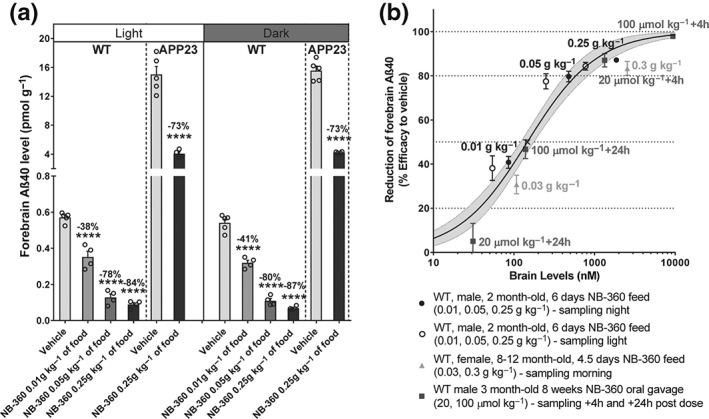Figure 2.

Establishment of NB‐360 treatment in food. (a) Effect of 6‐day NB‐360 dosing via food at different doses (0.01, 0.05, and 0.25 g·kg−1 NB‐360 in rodent food pellets on forebrain Aß40 levels in wild‐type (WT, n = 4–5) and APP23 (n = 4–5) male mice (2 months old) during the light and dark phase. Mean ± SEM. Statistics: one‐way ANOVA with Holm–Sidak multiple comparison test versus vehicle (***P < 0.0001) for WT and two‐tailed t test versus vehicle (****P < 0.0001) for APP23. (b) Pharmacokinetics/pharmacodynamics relationship of NB‐360 brain levels on forebrain Aß40 in WT mice (n = 4–5) at different ages, different doses, route of administration, and sampling time points as indicated. Mean ± SEM. Fitting equation: y = bottom + (top‐bottom)∕(1 + 10((LogIC50 −log X) * Hill slope)); bottom constraint = 0; top constraint = 100; and IC50 = 147 nM. The 95% confidence intervals were indicated. R 2 = 0.858. Rodent food pellets were provided by Granovit AG, Switzerland. Studies were approved by the Swiss Cantonal Veterinary Authority of Basel City, Switzerland, under Licence Number BS‐1094. C57BL/6J and transgenic, heterozygous APP23 (B6,D2‐Tg(Thy1App)23Sdz/B6.Cg‐Tg(Thy1‐APP)3Somm/J, available from Jackson Laboratory, Stock No. 030504) as well as APP23 wild‐type littermate controls were obtained from Novartis Pharma AG breeding colonies. Mice were housed in individually ventilated cage racks (maximum four mice per XJ‐type cage). The animals had access to food and water ad libitum. For brain compound and Aβ40 analysis, see Neumann et al. (2015)
